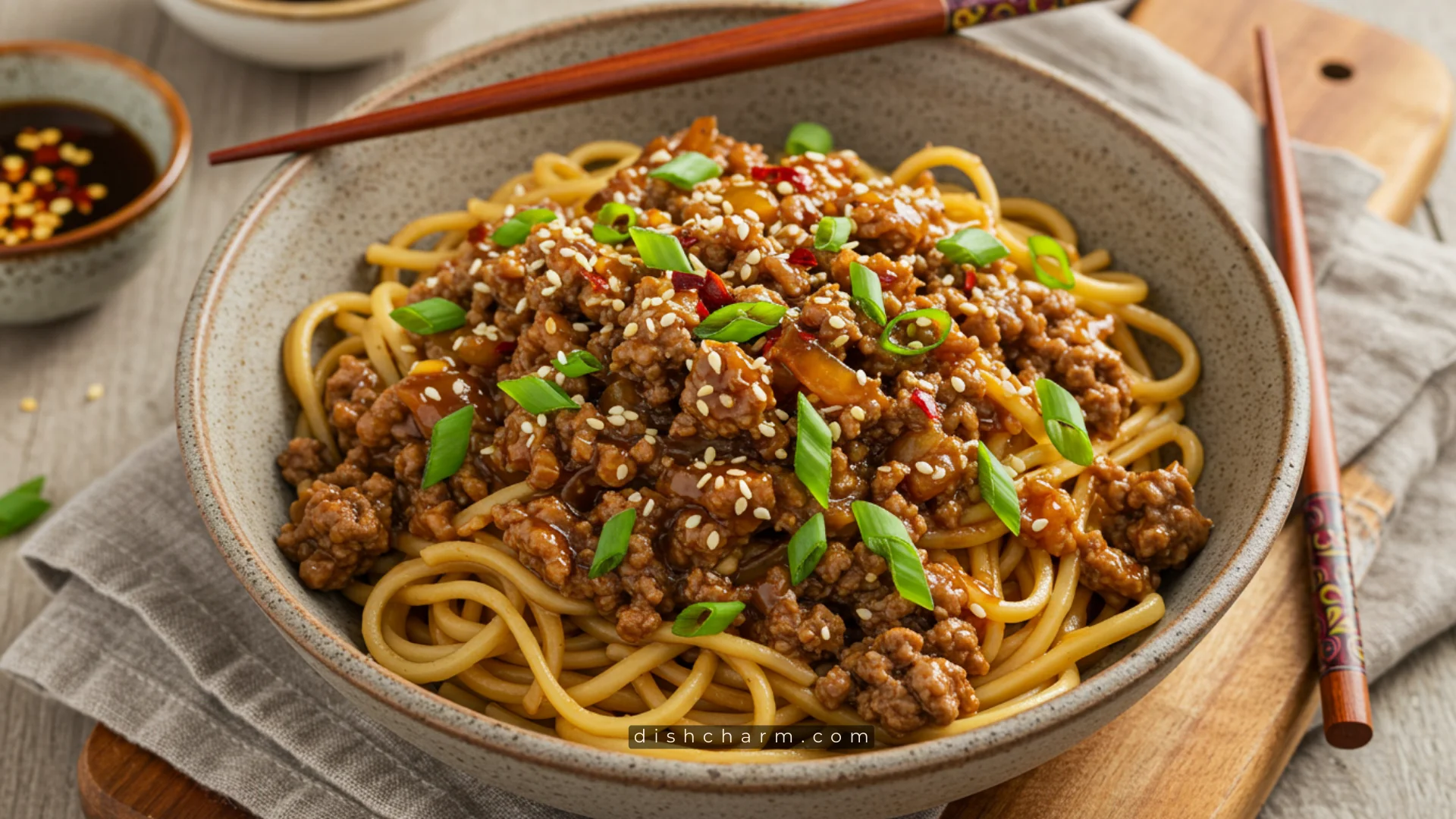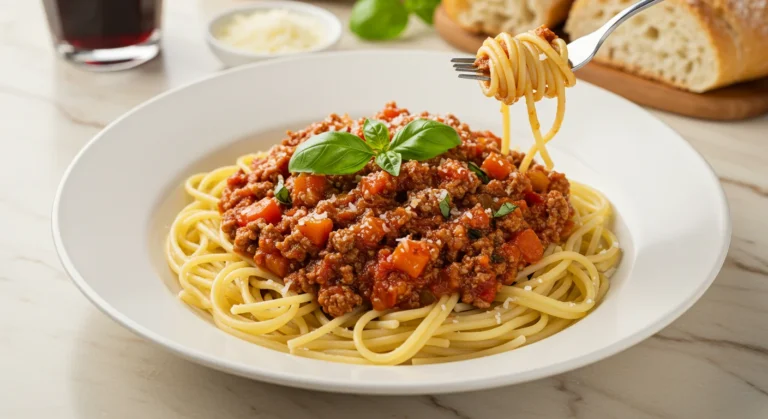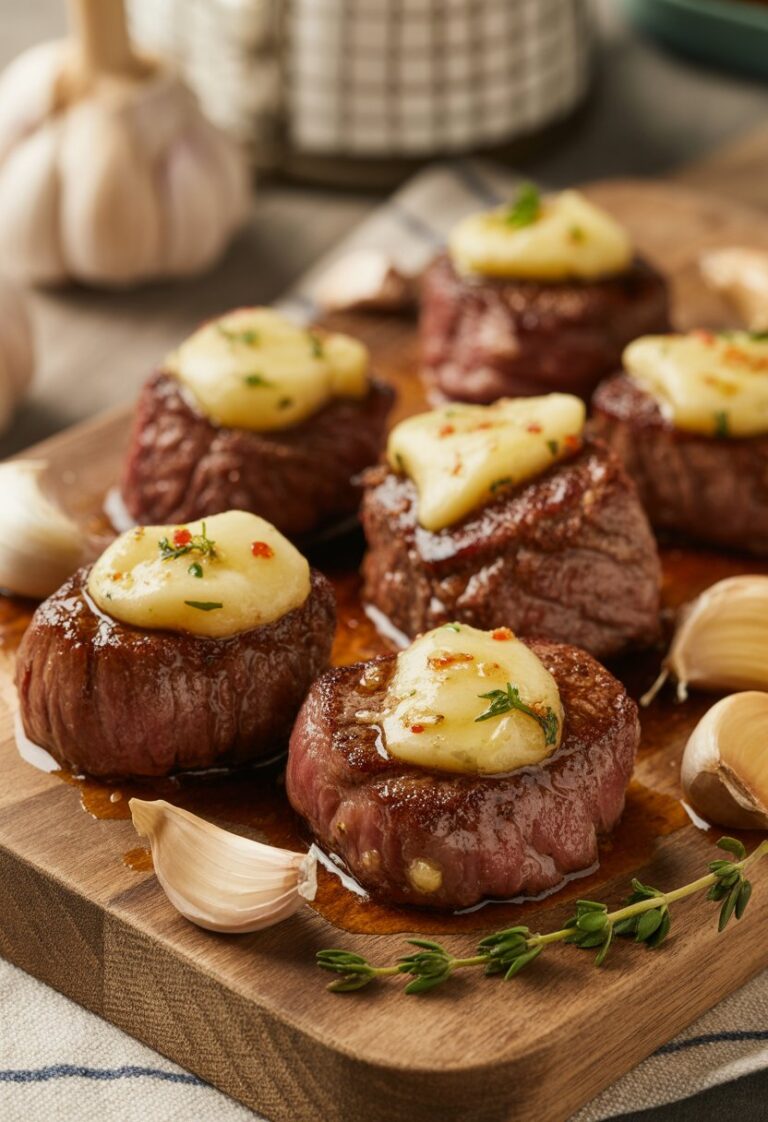Mongolian Ground Beef Noodles: Quick & Easy Weeknight Dinner
For those with hectic weeknights seeking a meal that’s both quick and satisfying, Mongolian Ground Beef Noodles are a standout choice. In just 15 to 30 minutes, this dish marries bold flavors with easy preparation, bringing together a delightful combination of sweet and spicy. Quick to prepare and rich in taste, Mongolian Ground Beef Noodles can become a go-to dish for anyone craving a hearty meal without spending hours in the kitchen.
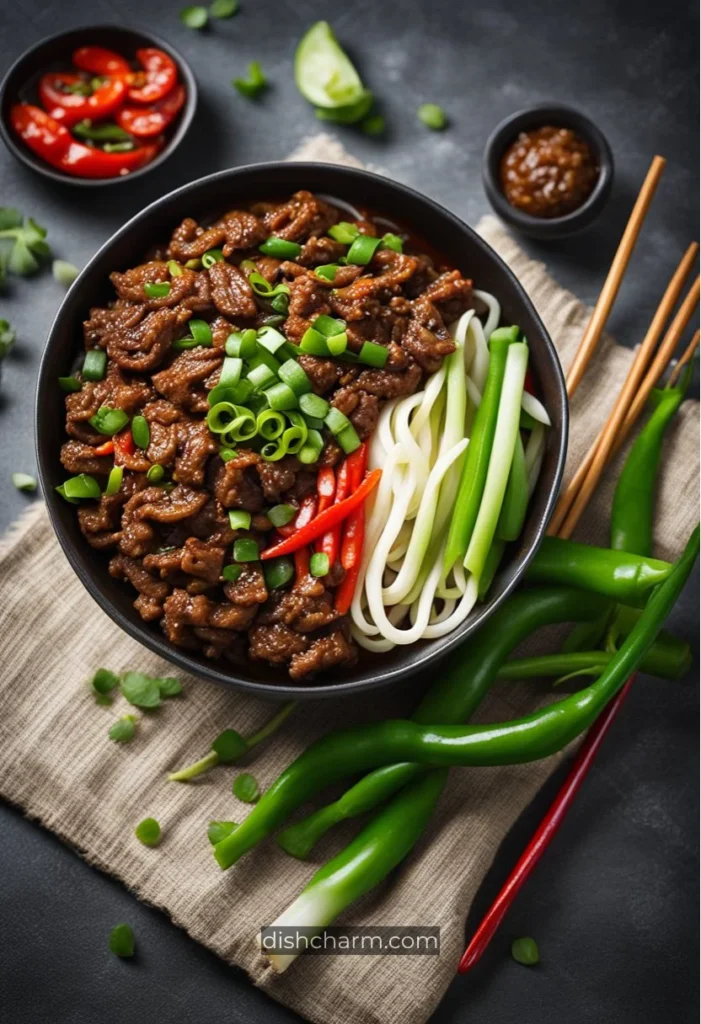
The heart of this dish lies in its simplicity and accessibility. Using ground beef and staple ingredients like soy sauce and ginger, it keeps cooking straightforward while delivering depth in flavor. The result is a comforting meal that doesn’t require restaurant-level skills or exotic ingredients.
With opportunities to customize and explore variations, this recipe lends itself to imaginative spins such as swapping in different proteins or adding vegetables. Serve these noodles on their own or enhance them with a side dish to round out the meal. Readers will appreciate the adaptability and flavor packed into each serving.
Key Takeaways
- Quick to make with basic ingredients
- Mixes sweet and spicy flavors
- Easily customizable to suit different tastes
Understanding Mongolian Beef Noodles
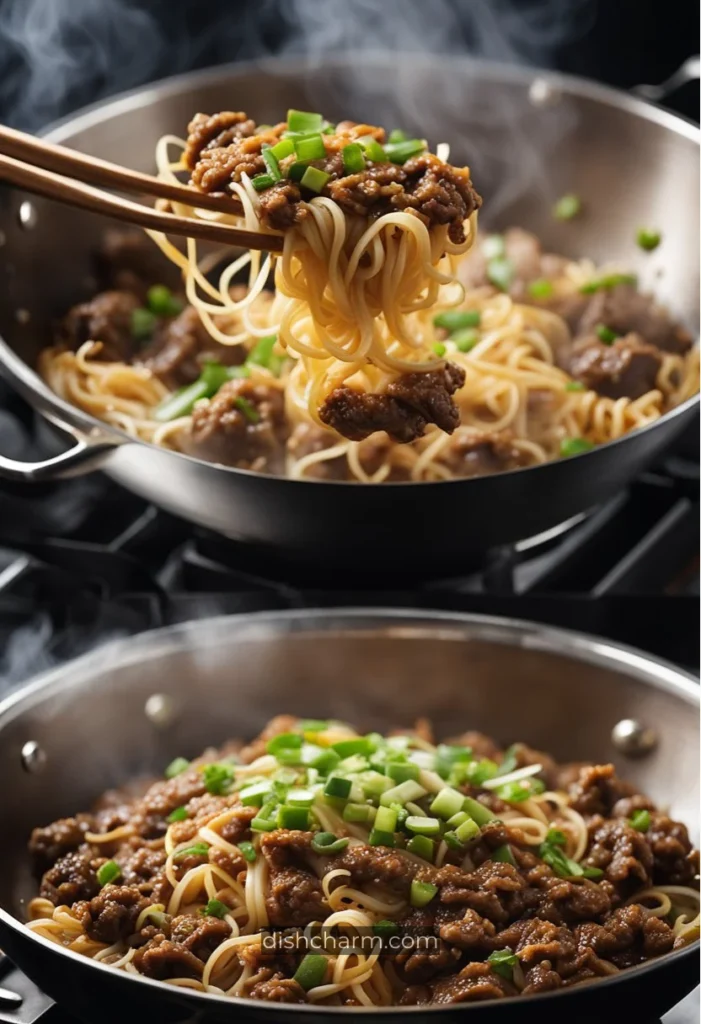
Mongolian Beef Noodles blend rich flavors and simple ingredients to create a satisfying dish. This complete meal combines ground beef with soy sauce, ginger, and garlic for a popular recipe. The addition of noodles makes it a crowd-pleaser that’s perfect for any occasion.
What is Mongolian Beef?
Mongolian Beef originates from Chinese-American cuisine rather than traditional Mongolian recipes. It is known for its savory-sweet flavor profile, often found in Chinese restaurants and popularized by places like P.F. Chang’s. The dish typically involves sliced beef stir-fried with soy sauce, ginger, and garlic. Green onions and sesame seeds are commonly added as garnishes. In noodle form, the dish uses similar bold flavors but with the convenience of ground beef, making it simple yet delicious.
The Role of Noodles in Asian Cuisine
Noodles play a major role in Asian diets as staple foods, similar to rice. They offer versatility, serving as a base for a variety of recipes, including Mongolian Beef Noodles. Different types of noodles, like Hokkien noodles, work well with the soybean-based sauces typically used. In this dish, the noodles soak up the rich flavors, providing a well-balanced combo of texture and taste. This approach respects the Asian flavor tradition, offering a dish that’s both hearty and easy to prepare.
Ingredients Overview
The core ingredients for Mongolian Beef Noodles include ground beef, soy sauce, and hoisin sauce, paired with beef broth. Ground ginger and garlic contribute to the dish’s signature flavor, while brown sugar adds sweetness. Green onions and sesame seeds are often used to enhance both flavor and appearance. For those aiming for a quick meal, these ingredients are uncomplicated and likely found in most kitchens. The combination creates a savory-sweet balance, making it a preferred choice for those looking for both taste and simplicity in a complete meal.
Preparation Essentials
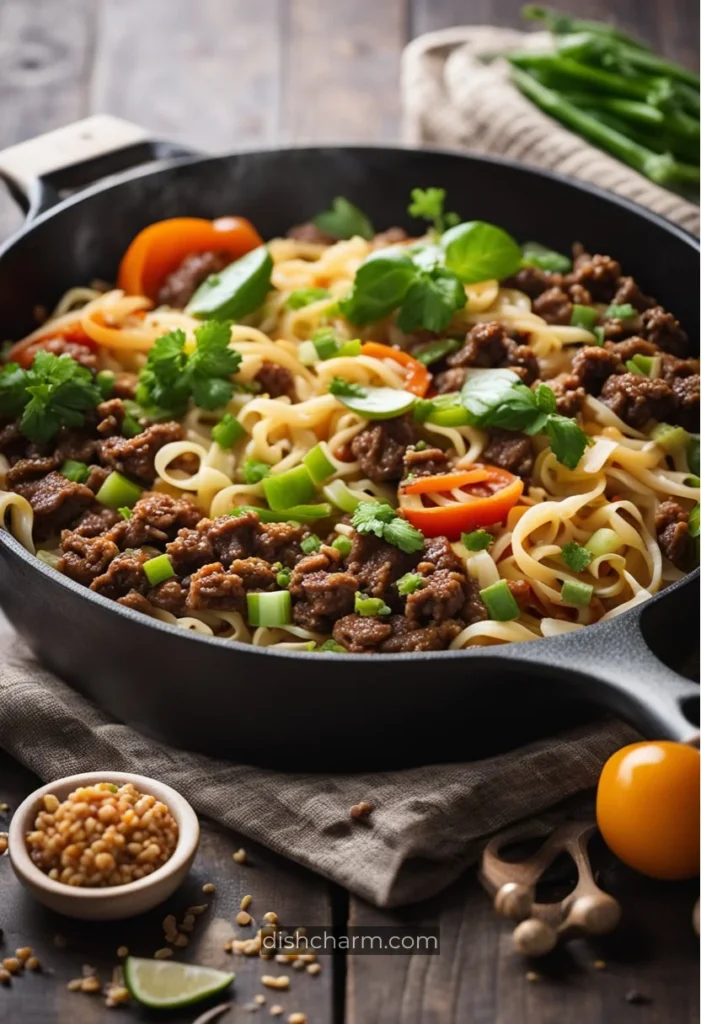
Crafting a flavorful dish like Mongolian Ground Beef Noodles involves having the right tools and ingredients, knowing how to choose the best beef, and understanding how to prepare and cook it efficiently. These essentials ensure an easy and enjoyable cooking experience.
Required Cooking Equipment
Using the right kitchen tools makes preparing Mongolian Ground Beef Noodles smoother. A large skillet is crucial, allowing all ingredients to mix well without crowding.
Stirring tools, like a wooden spoon or silicone spatula, help blend noodles and sauce consistently. Measuring cups and spoons are necessary to get precise amounts of beef broth, soy sauce, and other liquids for the sauce. A colander is useful for draining noodles once they are cooked, ensuring they don’t become soggy.
Selecting the Right Beef
Ground beef is commonly used in this recipe for its easy preparation and ability to soak up flavors well. Look for beef mince that is lean to avoid excess grease in the dish, which could alter the sauce’s consistency.
If an alternative to ground beef is desired, thinly sliced flank steak can bring a different texture and taste. Marinating flank steak with soy sauce or a similar marinade before cooking can enhance its flavor, creating a richer dish.
Prep Time and Cooking Tips
The total prep and cook time for Mongolian Ground Beef Noodles is usually less than 30 minutes, ideal for busy weeknight dinners. Begin by chopping ingredients like garlic and ginger in advance to save time during the cooking process.
Start with heating vegetable oil in the skillet, ensuring it’s hot enough for a quick stir fry, giving the beef a nice sear. Consistently stir the beef and sauce ingredients for even cooking and to avoid any burning.
Always taste and adjust seasoning after the noodles and sauce are combined, adding more spice or sweetness with red pepper flakes or brown sugar as needed. This flexibility lets home cooks tailor the flavor to their liking.
Cooking Mongolian Beef Noodles
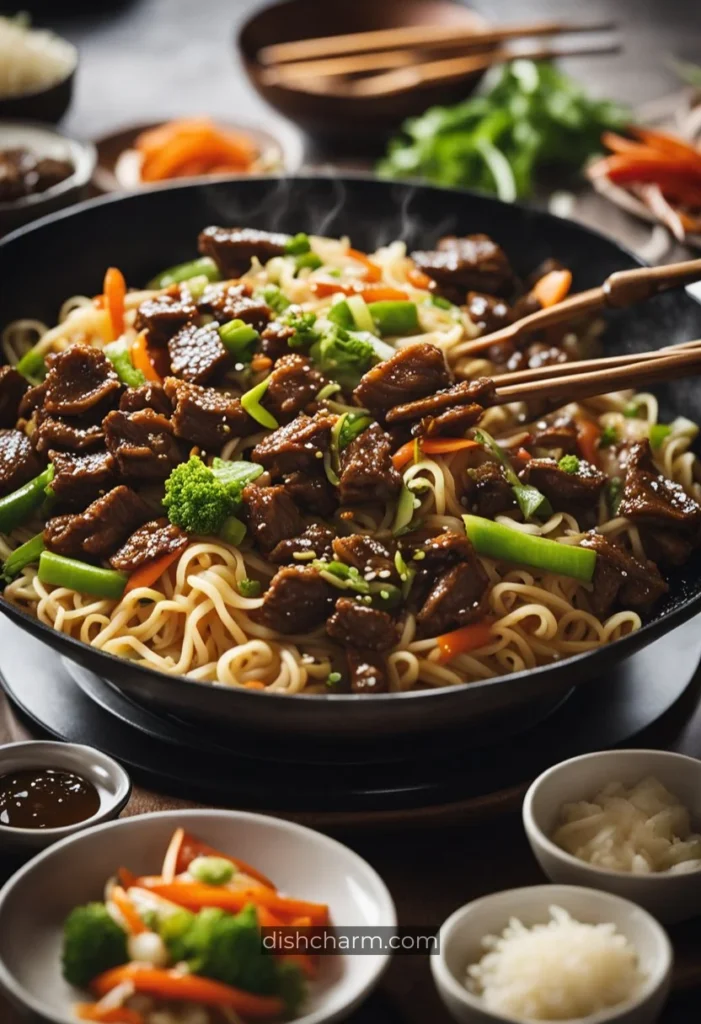
Cooking Mongolian Beef Noodles involves a quick and easy process that brings together savory ingredients like ginger, garlic, and soy sauce for a flavorful dish. These steps will guide you through creating a delicious meal with tender beef and perfectly cooked noodles.
Step-by-Step Cooking Instructions
To start, boil a large pot of water for the noodles. Use very hot water to ensure the noodles cook evenly. Meanwhile, heat a large skillet or wok. Add a drizzle of sesame oil to bring out the nutty aroma. Brown the ground beef until fully cooked.
As the beef cooks, keep stirring. This helps the meat break into small pieces for even cooking. Once the beef is browned, drain any excess fat. Leave a small amount to help cook the aromatics.
Next, add minced garlic and freshly grated ginger to the beef. Stir for a minute until fragrant. Transfer the noodles to the beef mixture, tossing them in to soak up the flavors.
Creating the Perfect Sauce
Crafting a delightful sauce is key. Combine soy sauce, hoisin sauce, and oyster sauce in a bowl. These sauces balance the saltiness and sweetness. For some heat, a pinch of white pepper works well.
Add a small amount of cornflour or cornstarch mixed with water for thickness. It gives the sauce a smooth texture. Optionally, add Shaoxing wine to deepen the flavors. Whisk everything until blended.
Pour the sauce over the beef and noodles. Stir to coat all ingredients evenly. Let it simmer briefly, allowing the flavors to meld.
Finishing Touches
The final touches make the dish pop. Slice green onions thinly and sprinkle them on top for freshness. Toasted sesame seeds add a crunch and nutty flavor. This complements the sweet-savoury profile of the dish.
Adjust seasonings to taste if needed. Extra soy sauce or a dash of sesame oil can enhance the dish further. Serve hot, immediately after cooking, to enjoy the texture and flavors at their best.
Customization and Alternatives
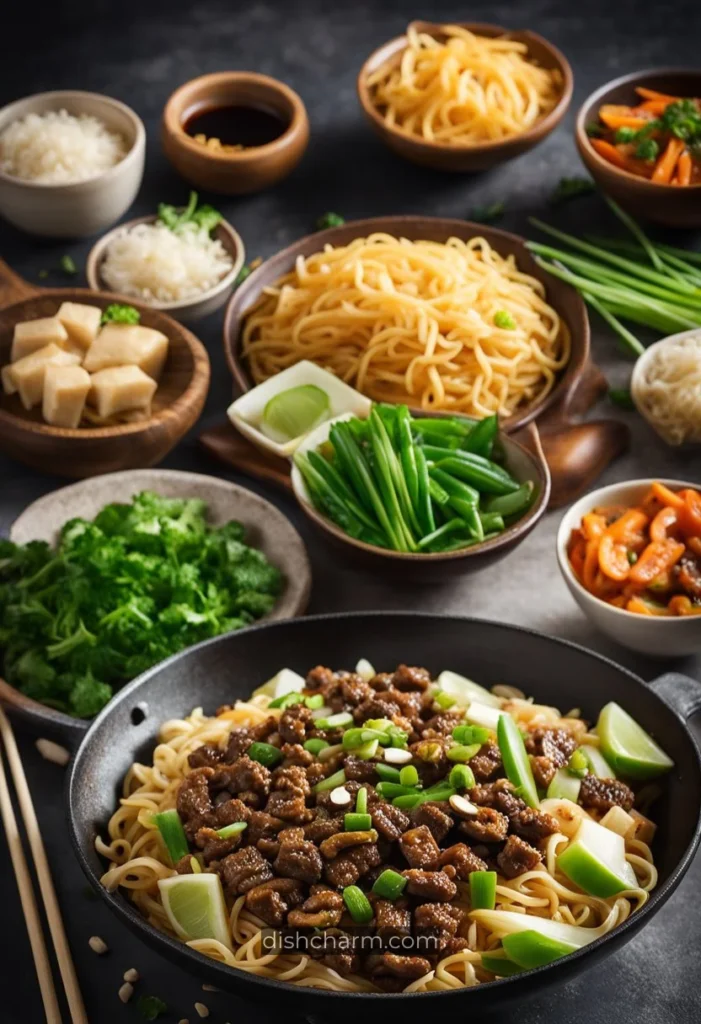
Mongolian Ground Beef Noodles can be tailored to fit various dietary preferences and culinary tastes. Adjustments can be made to accommodate dietary restrictions, or ingredients can be swapped for others, such as tofu or brown sugar alternatives, to create a new twist on the classic dish.
Adapting for Dietary Restrictions
For those who need a gluten-free option, tamari can replace regular soy sauce. It has a similar flavor but without gluten. Using rice noodles or verified gluten-free pasta ensures the dish remains safe for those with gluten sensitivities.
Increasing vegetable content can add nutrition and variety. Hidden vegetables like grated carrots or diced bell peppers can boost nutrients without overwhelming the dish. Tofu can be an excellent meat substitute for a vegetarian twist, bringing texture while absorbing the rich flavors of ginger and garlic.
Variations and Substitutes
When making Mongolian Ground Beef Noodles, experimenting with flavors can create exciting variations. Beef can be swapped with tofu for a vegetarian choice, or try minced chicken or turkey for a lighter version. For a sweeter taste, honey can substitute for brown sugar, slightly altering the sweetness but keeping it balanced.
For heat lovers, adding sambal oelek or a pinch of cayenne pepper can enhance the spice level, offering a bold kick. Udon noodles, linguini, or even spaghetti can replace traditional noodles, giving different textures to suit personal tastes. Adding bean sprouts provides a crunchy contrast, making each bite interesting. These tweaks let you make the dish uniquely your own.
Serving and Pairing Suggestions
Creating a complete meal with Mongolian Ground Beef Noodles involves choosing side dishes and beverages that enhance the flavors of the dish. Finding the right accompaniments can elevate the dining experience and delight the palate.
Complementary Side Dishes
Pairing Mongolian Ground Beef Noodles with vegetables like steamed broccoli or bok choy can add freshness and color to the plate. Vegetables can balance the savory and slightly sweet flavors of the noodles.
Another option is to serve the noodles with cooked rice. This adds a different texture and can make the meal more filling. Try adding sautéed mushrooms or stir-fried cabbage for extra variety and taste. These sides provide a nutritious complement to the main recipe without overpowering its distinct flavors, making a harmonious meal.
Wine and Beverage Pairings
When selecting beverages to enjoy with this dish, consider options that pair well with both the savory elements and the sweetness from the brown sugar and hoisin sauce used in the recipe. A light, crisp white wine like a Riesling or Pinot Gris can balance the rich flavors of the dish.
For those who prefer non-alcoholic choices, sparkling water with a splash of citrus can cleanse the palate, refreshing the taste buds between bites. A chilled dry sherry can also be an excellent match, enhancing the meat’s taste without overpowering the other ingredients.
Frequently Asked Questions
This section addresses the common queries related to preparing Mongolian Ground Beef Noodles, touching on ingredients, cooking times, and various tips.
What ingredients are needed for Mongolian ground beef noodles?
Key ingredients include ground beef, noodles, soy sauce, garlic, ginger, and brown sugar. Red pepper flakes are optional for added spice. Fresh vegetables like bell peppers or green onions can also be added for flavor.
How long does it take to prepare and cook Mongolian ground beef noodles?
The dish takes around 15 to 30 minutes to prepare and cook. With ingredients ready, the cooking process is quick, making it a great option for busy nights.
What are some common variations to the traditional Mongolian ground beef noodles recipe?
Different noodles, such as spaghetti or rice noodles, can be used. Additional vegetables like broccoli or carrots can enhance the dish. Adjust the sauce ingredients to suit your taste preferences.
Are there any tips for making Mongolian ground beef noodles for a large group?
Double or triple the recipe ingredients based on the number of servings needed. Use a large skillet or wok to accommodate the increased quantity. Prepare sauces and vegetables ahead of time to streamline cooking.
How can I adjust the spiciness level in a Mongolian ground beef noodles recipe?
To increase spiciness, add more red pepper flakes or sriracha sauce. For a milder version, reduce or omit the spicy ingredients. Taste adjust and taste throughout the cooking process to get your desired heat level.
What are some recommended side dishes to serve with Mongolian ground beef noodles?
Pair with steamed vegetables like broccoli or bok choy for balance. A simple salad or egg rolls can also complement the noodles. Serving with rice can extend the meal further.
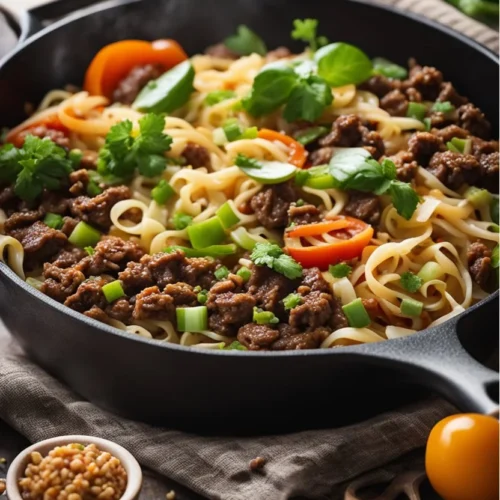
Mongolian Ground Beef Noodles
Equipment
- 1 Large skillet or wok For cooking beef and stir-frying ingredients.
- 1 Measuring Cups/Spoons Ensures accurate portions of sauces, spices, and liquids.
- 1 Wooden spoon or spatula For stirring noodles and sauce consistently.
- 1 Colander To drain cooked noodles without making them soggy.
- 1 Mixing Bowls For preparing sauce and organizing ingredients.
Ingredients
- 1 lb Ground beef or sliced beef Lean ground beef or thinly sliced flank steak works well.
- 8 oz Noodles (udon, linguini, etc.) Cook according to package instructions; drain and set aside.
- 1/4 cup Soy sauce Low-sodium recommended for dietary flexibility.
- 2 tbsp Hoisin sauce Adds sweetness and depth.
- 2 tbsp Brown sugar Balances the savory flavors.
- 1 tbsp Sesame oil For stir-frying and flavor enhancement.
- 1 Garlic clove (minced) Boosts aromatic complexity.
- 1 Ginger (minced) Adds zesty warmth.
- 1/2 tsp Red pepper flakes Adjust for heat preference.
- 1/4 cup Beef broth For creating the sauce base.
- 1 tbsp Cornstarch Mixed with water to thicken the sauce.
- 1 cup Bean sprouts Adds crunch and freshness.
Optional
- Sambal oelek or cayenne For extra spice.
- Garnish Green onions (chopped) For color and freshness.
Instructions
Prepare Ingredients :
- Cook noodles according to package instructions. Drain and set aside.
- Mince garlic and ginger. Chop green onions for garnish.
Make Sauce :
- In a small bowl, mix soy sauce, hoisin sauce, brown sugar, beef broth, and cornstarch slurry (1 tbsp cornstarch + 2 tbsp water). Set aside.
Cook Beef :
- Heat sesame oil in a large skillet or wok over medium-high heat. Add beef and cook until browned (about 5–7 minutes). Remove and set aside.
Stir-Fry Aromatics :
- In the same skillet, add minced garlic, ginger, and red pepper flakes. Sauté for 30 seconds until fragrant.
Combine Ingredients :
- Return beef to the skillet. Pour in the prepared sauce and stir continuously until the sauce thickens (2–3 minutes).
Add Vegetables and Noodles :
- Stir in cooked noodles and bean sprouts. Toss everything together until heated through.
Garnish and Serve :
- Garnish with chopped green onions. Serve hot with optional sides like steamed rice or sautéed vegetables.
Notes
-
- Customization: Swap noodles with udon, linguini, or spaghetti for different textures. Add sambal oelek or cayenne for extra spice.
- Vegetarian Option: Substitute beef with tofu or tempeh and use vegetable broth.
- Storage: Store leftovers in an airtight container in the fridge for up to 3 days. Reheat in a skillet with a splash of broth to prevent drying out.
Frequently Asked Questions
-
Can I use chicken instead of beef?
- Yes! Thinly sliced chicken breast or thighs work well as a substitute.
-
How can I make this dish gluten-free?
- Use tamari instead of soy sauce and ensure hoisin sauce is gluten-free. Choose gluten-free noodles.
-
What’s the best way to reheat leftovers?
- Reheat in a skillet over medium heat with a splash of broth or water to restore moisture.
-
Can I freeze this dish?
- Freeze sauce and beef separately from noodles to prevent sogginess. Thaw overnight in the fridge before reheating.
-
How do I thicken the sauce?
- Mix 1 tbsp cornstarch with 2 tbsp water and stir into the sauce during cooking.
Tips & Tricks
- Flavor Enhancement: Add a drizzle of sesame oil at the end for extra aroma.
- Texture Contrast: Include bean sprouts or shredded carrots for added crunch.
- Wine Pairing: Serve with a light white wine like Riesling or Pinot Gris to complement the dish.
Presentation Tips
- Garnish: Sprinkle chopped green onions and sesame seeds for a pop of color.
- Serving Style: Serve in a large bowl with chopsticks for an authentic touch. Pair with steamed rice or sautéed vegetables for a complete meal.
- Beverage Pairings: Offer sparkling water with citrus or chilled dry sherry for non-alcoholic options.

